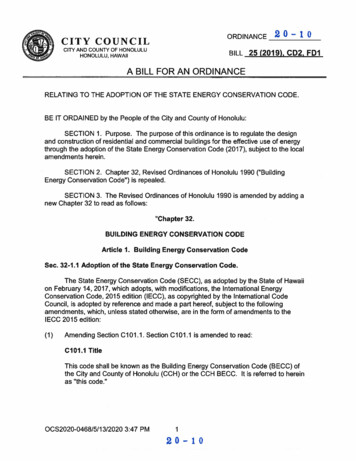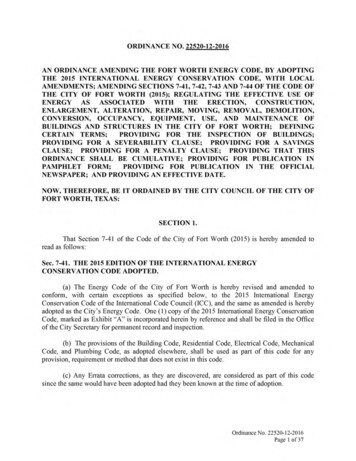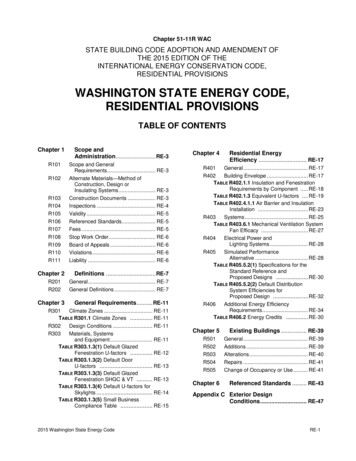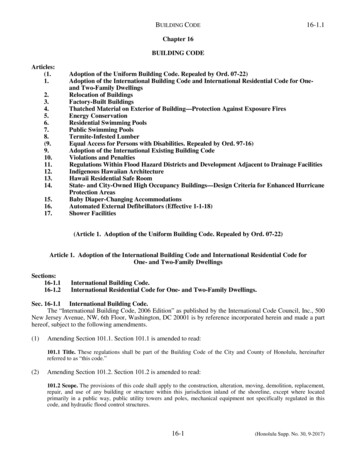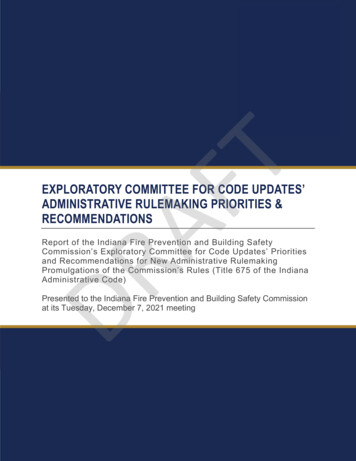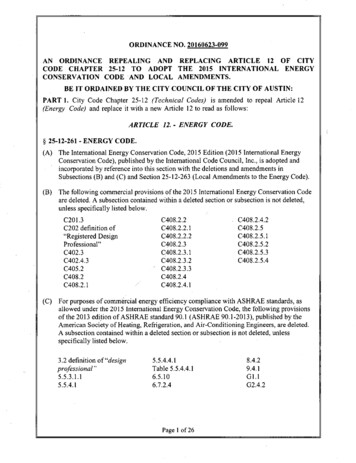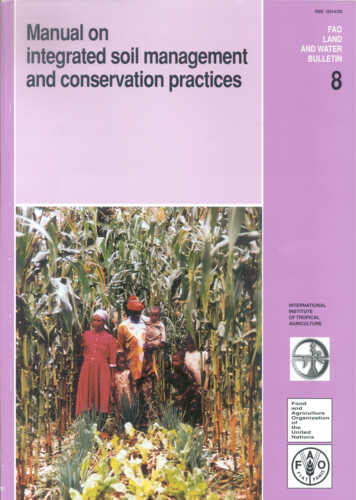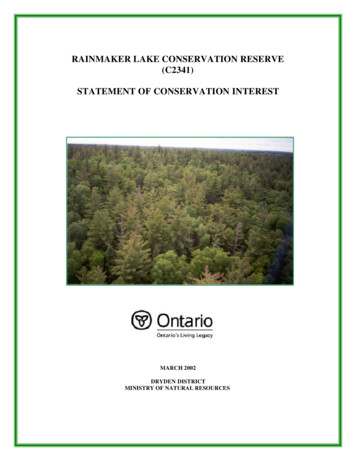
Transcription
Florida Building Code, EnergyConservation, 7th Edition (2020)vs. 2018 International EnergyConservation Code ResidentialStringency AnalysisFSEC-CR- 2102-20DRAFT Final ReportNovember 16, 2020Submitted toDepartment of Business and Professional RegulationOffice of Codes and Standards2601 Blair Stone RoadTallahassee, FL 32399Contract No. 132677Submitted byJeffrey Sonne and Robin VieiraCopyright 2020 Florida Solar Energy Center/University of Central FloridaAll Rights Reserved.
DisclaimerThe Florida Solar Energy Center/University of Central Florida nor any agency thereof, nor any oftheir employees, makes any warranty, express or implied, or assumes any legal liability orresponsibility for the accuracy, completeness, or usefulness of any information, apparatus,product, or process disclosed, or represents that its use would not infringe privately ownedrights. Reference herein to any specific commercial product, process, or service by trade name,trademark, manufacturer, or otherwise does not necessarily constitute or imply its endorsement,recommendation, or favoring by the Florida Solar Energy Center/University of Central Florida orany agency thereof. The views and opinions of authors expressed herein do not necessarily stateor reflect those of the Florida Solar Energy Center/University of Central Florida or any agencythereof.i
Executive SummaryThis project was initiated to review residential provisions of the Florida Building Code, EnergyConservation, 7th Edition (2020) (FBC-EC) in order to make a determination if it meets orexceeds the 2018 International Energy Conservation Code (IECC).This project’s code stringency evaluation activities included: Reviewing residential provisions of the 2020 FBC-EC and comparing them with residentialprovisions of the 2018 IECCListing impactful code differences by Mandatory, Prescriptive, Performance and EnergyRating Index categories and providing the anticipated stringency impact for eachUsing EnergyGauge USA energy modeling software to compare 2018 IECC and 2020 FBC-ECPrescriptive and Performance compliance method stringencies.The comparison of the 2020 FBC-EC to the 2018 IECC showed a range of stringency impacts,from making the Florida code more stringent to no impact to making the Florida code lessstringent. A number of the changes only apply in certain cases such as if a multi-family project,or if certain efficiency credits apply to a project. Two of the most significant changes betweenthe two codes are the increased FBC-EC maximum building air leakage ACH50 and the FBC-ECstorage water heater heat trap requirement, the first making the Florida code somewhat lessstringent and the second making it slightly more stringent in applicable cases.Prescriptive and Performance compliance method based simulations were performed for oneand two story single-family sample houses and a multi-family unit in three Florida citiesrepresenting the two Florida Climate Zones: Miami (Climate Zone 1), Tampa (Climate Zone 2)and Jacksonville (Climate Zone 2). Simulation results showed 2018 IECC Prescriptivecompliance to be somewhat more stringent overall than 2020 FBC-EC Prescriptive compliance,but 2018 IECC Performance compliance to be slightly less stringent overall compared with 2020FBC-EC Performance compliance.A number of construction type, component and equipment variables enter into an energy codecomparison so actual results will depend on the details of the projects eventually built underthe new code. However, evaluated as outlined in this report, the 2020 FBC-EC was shown tostart to slightly exceed the stringency of the 2018 IECC if 90% or more of compliance is via thePerformance method.ii
ContentsDisclaimer. iExecutive Summary . iiContents . iiiIntroduction . 1Impactful Differences between the 2020 FBC-EC and 2018 IECC . 1Requirements and Compliance Options . 1General Requirements . 1Mandatory Requirements. 2Prescriptive Compliance . 7Performance Compliance . 9Energy Rating Index Compliance . 19Other Relevant Code Changes . 20Code Changes Summary . 22Prescriptive and Performance Compliance Simulations. 26Prescriptive Compliance Simulations. 26Performance Compliance Simulations. 30Discussion . 34Conclusions . 36Acknowledgements . 36References . 36iii
IntroductionThis report summarizes the review and evaluation activities carried out to make adetermination whether the residential provisions of the 7th Edition (2020) Florida Building Code,Energy Conservation (referred to in this report as the FBC-EC) meet or exceed those of the 2018International Energy Conservation Code (IECC) code. 1Residential code stringency evaluation activities included: Reviewing residential provisions of the 2020 FBC-EC and comparing them with residentialprovisions of the 2018 IECCListing impactful code differences by Mandatory, Prescriptive, Performance and EnergyRating Index sections and providing anticipated stringency impact for each changeUsing EnergyGauge USA energy modeling software to compare 2018 IECC and 2020 FloridaEnergy Code Prescriptive and Performance compliance method stringencies.Impactful Differences between the 2020 FBC-EC and 2018 IECCA listing of impactful code differences between the 2020 FBC-EC and 2018 IECC is providedbelow, organized by General, Mandatory, Prescriptive, Performance and Energy Rating Indexsections. Anticipated stringency impacts are also provided for each code difference.Requirements and Compliance OptionsResidential Chapter 3 of both the 2020 FBC-EC and 2018 IECC stipulates several generalcompliance requirements. Residential Chapter 4 of both codes includes additional mandatoryrequirements that apply to all projects and three compliance method options:- Sections R401 through R404, commonly referred to as “Prescriptive” option- Section R405, the “Simulated Performance Alternative” or “Performance” option- An “Energy Rating Index” or “ERI” approach option in Section R406.General RequirementsThere are a number of Section R303 Materials, Systems and Equipment differences betweenthe 2020 FBC-EC and 2018 IECC. The 2020 FBC-EC adds several requirements to the 2018 IECCinsulation requirements including the following.R303.1.1.1.1The 2020 FBC-EC includes a subsection regarding insulation R-value that is not included in the2018 IECC:This report is an update of a 2017 FBC-EC vs. 2015 IECC stringency comparison report; as such, the same orsimilar discussion language is often used where the differences between these earlier code editions persist.11
R303.1.1.1.1 R-values referenced in Chapter 4 of this code refer to the R-values ofthe added insulation only. The R-values of structural building materials such asframing members, concrete blocks or gypsum board shall not be included.Exception: R402.1.5 Total UA Alternative.Depending on common practice, this clarification may make the 2020 FBC-EC slightly morestringent than the 2018 IECC.R303.2.1 Insulation InstallationThe 2020 FBC-EC includes the following section regarding insulation installation that is notincluded in the 2018 IECC:R303.2.1 Insulation installation. Insulation materials shall comply with therequirements of their respective ASTM standard specification and shall be installedin accordance with their respective ASTM installation practice in Table R303.2.1 insuch a manner as to achieve rated R-value of insulation. Open-blown or pouredloose-fill insulation shall not be used in attic roof spaces when the slope of theceiling is more than three in twelve. When eave vents are installed, baffling of thevent openings shall be provided to deflect the incoming air above the surface of theinsulation.Exception: Where metal building roof and metal building wall insulation iscompressed between the roof or wall skin and the structure.Again depending on common practice, these requirements together with the additionalrequirements of this section’s compressed insulation, substantial contact and insulationprotection subsections may make the 2020 FBC-EC slightly more stringent than the 2018 IECC.Mandatory RequirementsEach 2018 IECC and 2020 FBC-EC compliance option includes mandatory requirements. Thereare several impactful differences between the 2018 IECC and 2020 FBC-EC mandatoryrequirements.R402.4.1.2 TestingSection R402.4.1.2 from the 2020 FBC-EC below shows the building testing language changesfrom the 2018 IECC in strike-out and underline format:R402.4.1.2 Testing.The building or dwelling unit shall be tested and verified as having an air leakagerate not exceeding five seven air changes per hour in Climate Zones 1 and 2, andthree air changes per hour in Climate Zones 3 through 8. Testing shall be conductedin accordance with RESNET/ICC 380, ASTM E 779 or ASTM E 1827ANSI/RESNET/ICC380 and reported at a pressure of 0.2 inch w.g. (50 Pascals). Where required by thecode official, Testing shall be conducted by either individuals as defined in Section2
553.993(5) or (7), Florida Statutes or individuals licensed as set forth in Section489.105(3)(f), (g), or (i) or an approved third party. A written report of the resultsof the test shall be signed by the party conducting the test and provided to the codeofficial. Testing shall be performed at any time after creation of all penetrations ofthe building thermal envelope. [no change to remaining text in section]Changing the maximum leakage rate from five air changes per hour (ACH50 5) to sevenchanges per hour (ACH50 7) in Climate Zones 1 and 2 (all of Florida) results in the 2020 FBC-ECbeing somewhat less stringent than the 2018 IECC. This modification is however due to 2016Florida legislation which required the change in response to homebuilders concerns regardingtight houses without reliable mechanical ventilation systems.As also shown above, the 2018 IECC continues to allow the requirement for tester approval tobe at the discretion of the code official. This difference may result in the 2020 FBC-EC beingslightly more stringent in some cases (depending on typical practice).An additional Florida change provides an exception to the Section R402.4.1.2 testingrequirement:EXCEPTION: Testing is not required for additions, alterations, renovations, orrepairs, of the building thermal envelope of existing buildings in which the newconstruction is less than 85% of the building thermal envelope.This change should continue to help clarify testing requirements and slightly reduce the amountof testing required in the state, but little or no stringency impact is anticipated.R402.4.2 FireplacesA Section R402.4.2 change between the 2015 IECC and 2018 IECC removed a UL 907 listing andlabeling requirement for the doors of masonry fireplaces. The rationale provided for thechange was in part that “according to testing laboratories, there is no way to test to thatstandard,” so as a result, keeping the standard “will actually limit, or possibly eliminate, theinstallation of doors.” The 2020 FBC-EC still includes the UL 907 listing and labelingrequirement. Based on the rationale provided, this 2018 IECC change could make it slightlymore stringent than the 2020 FBC-EC in applicable cases.R403.3.2 SealingSection R403.3.2 from the 2020 FBC-EC below shows the 2018 IECC duct sealing language againwith Florida changes shown in strike-out and underline format:R403.3.2 Sealing (Mandatory). All dDucts, air handlers, and filter boxes andbuilding cavities that form the primary air containment passageways for airdistribution systems shall be sealed considered ducts or plenum chambers, shall beconstructed and sealed in accordance with Section C403.2.9.2 of the CommercialProvisions of this code and shall be shown to meet duct tightness criteria below.3
Joints and seams shall comply with either the International Mechanical Code orInternational Residential Code, as applicable.Duct tightness shall be verified by testing in accordance with ANSI/RESNET/ICC 380by either individuals as defined in Section 553.993(5) or (7), Florida Statutes, orindividuals licensed as set forth in Section 489.105(3)(f), (g), or (i), Florida Statutes,to be “substantially leak free” in accordance with Section R403.3.3.While the 2020 FBC-EC has a number of changes to this section, most will either havelimited impact on stringency, or the impact would be difficult to assess without longterm field data.R403.3.3 Duct TestingExceptions to the 2020 FBC-EC Section R403.3.3 Duct Testing section are provided below with2020 FBC-EC changes to the 2018 IECC shown in strike-out and underline format:Section R403.3.3 Duct testing (Mandatory). [No change to text]Exceptions:1. A duct air leakage test shall not be required where the ducts and air handlers arelocated entirely within the building thermal envelope.2. A duct air-leakage test shall not be required for ducts serving heat or energy recoveryventilators that are not integrated with ducts serving heating or cooling systems.2. Duct testing is not mandatory for buildings complying by Section R405 of this code.Duct leakage testing is required for Section R405 compliance where credit is taken forleakage, and a duct air leakage Qn to the outside of less than 0.080 (where Qn ductleakage to the outside in cfm per 100 square feet of conditioned floor area tested at 25Pascals) is indicated in the compliance report for the proposed design.Struck-out Exception 2 above regarding heat and energy recovery ventilators is a clarification inthe 2018 IECC; as such, it is not a change in code stringency. Underlined Exception 2 is anadditional Florida duct testing exception that only applies to Section R405 of the code(Performance compliance), so it does not affect Prescriptive compliance stringency.Performance compliance implications are discussed in the Performance Compliance sectionbelow.R403.3.6 Ducts buried within ceiling insulationThe 2018 IECC includes a new section regarding supply and return air ducts that are partially orcompletely buried in ceiling insulation along with a new subsection that stipulates an effectiveduct insulation R-value of R-25 be used for performance simulations for deeply buried ductsthat meet certain placement and insulation conditions. Buried ducts language codemodifications were submitted for the FBC-EC, but none were finally approved. Little or nostringency impact is anticipated from these changes.4
R403.3.7 Ducts located in conditioned spaceThe 2018 IECC includes a new section that specifies two separate conditions under which ductsare considered as being inside conditioned space:1. Duct systems that are “located completely within the continuous air barrier and withinthe building thermal envelope”2. Buried ducts that meet specified air handler location (within the continuous air barrierand building thermal envelope), duct leakage, and ceiling insulation R-valuerequirements.Regarding the first condition, ducts that are completely within the continuous air barrier andbuilding thermal envelope may still be in an unconditioned space such as a sealed attic. Ductwork in sealed attics typically experiences summer afternoon temperatures about 5oF higherthan conditioned space temperatures, 2 so the specified condition is not equivalent to beinginside conditioned space. The second condition is also not seen as being equivalent to beinginside conditioned space. So this change makes the 2018 IECC slightly less stringent than the2020 FBC-EC in cases where it is used for compliance.R403.5.5 Heat TrapsSection R403.5 of the 2020 FBC-EC requires heat traps for storage water heaters:R403.5.5 Heat traps (Mandatory). Storage water heaters not equipped with integralheat traps and having vertical pipe risers shall have heat traps installed on both theinlets and outlets. External heat traps shall consist of either a commercially availableheat trap or a downward and upward bend of at least 3½ inches (89 mm) in the hotwater distribution line and cold water line located as close as possible to the storagetank.This heat trap requirement increases Florida Prescriptive, Performance and ERI compliancestringency slightly relative to the 2018 IECC in applicable cases.R403.7.1 Equipment sizingSubsections under 2020 FBC-EC Section R403.7 provide additional cooling and heating systemsizing requirements and exceptions that are not included in the 2018 IECC system sizing section.Depending on typical practice, it is anticipated that these additions will slightly increase thestringency of the 2020 FBC-EC relative to the 2018 IECC.Parker, D., J. Sonne, and J. Sherwin. 2002. Comparative Evaluation of the Impact of Roofing Systems onResidential Cooling Energy Demand in Florida. Proceedings of ACEEE 2002 Summer Study, American Council for anEnergy Efficient Economy, Washington, DC; CR-1220-00.pdf25
R403.10.3 CoversA 2018 IECC change increases from 70% to 75% the heated pool and outdoor permanent spaheating energy that must come from a heat pump or on-site renewable energy to exempt thepool or spa from the cover requirement. The 2018 IECC also specifies the 75% heat pump oron-site renewable heating energy must be computed over an operation season of not less thanthree calendar months. These change make the 2018 IECC slightly more stringent than the2020 FBC-EC in applicable cases.R403.13 DehumidifiersNew 2020 FBC-EC Section R403.13 provides minimum efficiency, control, insulation andcondensate disposal requirements for dehumidifiers (only applicable if dehumidifiers areinstalled):R403.13 Dehumidifiers (Mandatory). If installed, a dehumidifier shall conform tothe following requirements:1. The minimum rated efficiency of the dehumidifier shall be greater than 1.7liters/ kWh if the total dehumidifier capacity for the house is less than 75pints/day and greater than 2.38 liters/kWh if the total dehumidifier capacity forthe house is greater than or equal to 75 pints/day.2. The dehumidifier shall be controlled by a sensor that is installed in a locationwhere it is exposed to mixed house air.3. Any dehumidifier unit located in unconditioned space that treats air fromconditioned space shall be insulated to a minimum of R-2.4. Condensate disposal shall be in accordance with Section M1411.3.1 of theFlorida Building Code, Residential.An additional new FBC-EC subsection, R403.13.1, provides configuration and insulationrequirements for ducted dehumidifiers. Depending on typical practice, in applicable cases,these changes together should increase the stringency of the 2020 FBC-EC slightly relative tothe 2018 IECC.R404.1 Lighting equipmentA 2020 FBC-EC change replaces the Definitions section defined “high-efficacy” term withminimum lumens per watt efficacy specifications and increases the percentage of permanentlyinstalled lamps that must have these minimum efficacies from 75% to 90%. The 2018 IECC alsohas a 90% high efficacy requirement but keeps the high-efficacy definition. The net result ofthese changes is that there is now very little difference in lighting stringency between the 2020FBC-EC and 2018 IECC.6
Other Mandatory ChangesThere are several additional Mandatory differences between the 2020 FBC-EC and the 2018IECC which either do not directly affect stringency or the impact of which would be difficult todetermine, such as the Section R402.4 FBC-EC exception that allows R-2 Occupancies andmultiple attached single family dwellings to comply with commercial code air leakage testingrequirements.Prescriptive ComplianceSection R402 of the 2018 IECC and 2020 FBC-EC provides residential building thermal enveloperequirements for prescriptive compliance centered around component efficiencies listed inTables R402.1.2 and R402.1.4.Table R402.1.2 Insulation and Fenestration Requirements by ComponentSection R402 Table R402.1.2 “Insulation and Fenestration Requirements by Component” of the2018 IECC provides specific requirements by building component together with clarifying notes:While only Climate Zones 1 and 2 of Table R402.1.2 apply to Florida, the 2020 FBC-EC alsoincludes this entire table, with no substantive Florida changes except the addition of note “j”:7
j. For impact rated fenestration complying with Section R301.2.1.2 of the FloridaBuilding Code, Residential or Section 1609.1.2 of the Florida Building Code, Buildingthe maximum U-factor shall be 0.65 in Climate Zone 2.In allowing a maximum Climate Zone 2 U-factor of 0.65 for impacted rated fenestration vs. the2018 IECC’s 0.4 value which does not differentiate for impact fenestration, the note “j” changedecreases 2020 FBC-EC Prescriptive compliance stringency slightly in applicable cases relative tothe 2018 IECC.Table R402.1.4 Equivalent U-FactorsTable R402.1.4 “Equivalent U-Factors” of the 2018 IECC provides assembly U-factors for anumber of components that can be used as alternatives to R-value requirements in TableR402.1.2:Only Climate Zones 1 and 2 of Table R402.1.4 apply to Florida, but the 2020 FBC-EC againincludes the entire table, with only slight wording changes (no stringency differences)compared with the 2018 IECC version of the table.R402.2.2 Ceilings without attic spacesThe 2018 IECC adds a stipulation for ceilings without attic spaces that also do not havesufficient space for otherwise required above R-30 insulation, that requires insulation to extendover the top of the wall plate to the outer edge of the plate and not be compressed. Thischange makes the 2018 IECC slightly more stringent than the 2020 FBC-EC in applicablePrescriptive compliance cases.Table R402.2.6 Steel-Frame Ceiling, Wall and Floor Insulation R-valuesA 2018 IECC change removes the R-19 2.1, 16” on center, steel frame wall R-13 wood frameequivalence option from Table R402.2.6. This change makes the 2018 IECC slightly morestringent than the 2020 FBC-EC in applicable Prescriptive compliance cases.8
R403.3.6 Air Handling unitsThe 2020 FBC-EC includes Section R403.3.6 which prohibits the installation of air handlers inattics for prescriptive compliance:R403.3.6 Air-handling units. Air handling units shall not be installed in the atticwhen a home is brought into code compliance by Section R402. There are a number of new homes, particularly in South Florida, where installing air handlers inthe attic is common. While the number of air handlers that would have been installed in atticsin Florida without this code section cannot be known, this section makes 2020 FBC-ECPrescriptive compliance more stringent than 2018 IECC Prescriptive compliance.R403.7.2. Electric space heatingA 2020 FBC-EC change prohibits electric resistance space heating from being the primaryheating system used in Climate Zone 2 for Prescriptive compliance. This change will make theFBC-EC more stringent than the 2018 IECC in applicable cases.Performance ComplianceSection R405 of the 2018 IECC and 2020 FBC-EC provides a Simulated Performance Alternative,or “Performance” compliance option that compares heating, cooling and water heating energycosts (IECC) or annual loads (FBC-EC) for a proposed project building with those of a referencebuilding of the same size. The 2020 FBC-EC includes a number of Performance compliancedifferences from the 2018 IECC.R405.2.1 Ceiling insulationThe 2020 FBC-EC includes Section R405.2.1 which requires minimum Performance ceilinginsulation levels:R405.2.1 Ceiling insulation. Ceilings shall have an insulation level of at least R-19,space permitting. For the purposes of this code, types of ceiling construction thatare considered to have inadequate space to install R-19 include single assemblyceilings of the exposed deck and beam type and concrete deck roofs. Such ceilingassemblies shall be insulated to at least a level of R-10.While this subsection means only the Florida code has a Performance compliance ceilinginsulation minimum, since both the Florida and IECC Performance compliance methodsmaintain a set overall efficiency requirement, it does not increase the stringency of the FBC-ECrelative to the IECC.R405.2.2 Building air leakage testingThe 2020 FBC-EC includes new Section R405.2.2 which clarifies Performance compliancebuilding air leakage rate limits:9
R405.2.2 Building air leakage testing. Building or dwelling air leakage testing shallbe in accordance with Sections R402.4 through R402.4.1.2. If an air leakage ratebelow seven air changes per hour at a pressure of 0.2 inch w.g. (50 Pascals) isspecified for the proposed design, testing shall verify the air leakage rate does notexceed the air leakage rate of the proposed design instead of seven air changes perhour.Based on anecdotal evidence of typical practice and enforcement, this change should slightlyincrease the stringency of the 2020 FBC-EC compared with the 2018 IECC.R405.2.3 Duct air leakage testingThe 2020 FBC-EC includes new Section R405.2.3 which clarifies when Performance complianceduct air leakage testing is required, and in cases where testing is required, that the maximumleakage rate allowed is the leakage value entered for the proposed design:R405.2.3 Duct air leakage testing. In cases where duct air leakage lower than thedefault Qn to outside of 0.080 (where Qn duct leakage to the outside in cfm per100 square feet of conditioned floor area tested at 25 Pascals) is specified for theproposed design, testing in accordance with Section R403.3.2 shall verify a duct airleakage rate not exceeding the leakage rate of the proposed design. Otherwise, inaccordance with Section R403.3.3, duct testing is not mandatory for buildingscomplying by Section R405.Based on anecdotal evidence of typical practice and enforcement, this change should slightlyincrease the stringency of the 2020 FBC-EC compared with the 2018 IECC.R403.3.3 Duct TestingAs shown above in the Mandatory Requirements section of this report, an exception added toSection R403.3.3 of the FBC-EC allows compliance via the Performance method without ductleakage testing, regardless of whether the ducts are in conditioned space or not. While thisexception allows leakier ducts for Florida Performance compliance, since there is a non-tested“default leakage penalty” built into the calculation and again the Performance compliancemethod maintains a set overall efficiency requirement, it does not make the 2020 FBC-EC lessstringent than the 2018 IECC.R405.3 Performance-based ComplianceSection R405.3 differences between the 2020 FBC-EC and 2018 IECC address how performancecompliance is calculated and include a FBC-EC reference to Appendix RC that providescalculation details (FBC-EC changes to the 2018 IECC shown here in strike-out and underlineformat):R405.3 Performance-based compliance. Compliance based on simulated energyperformance requires that a proposed residence (proposed design) be shown tohave an annual energy cost total normalized Modified Loads that is are less than or10
equal to the annual energy cost total loads of the standard reference design ascalculated in accordance with Appendix RC of this standard. Energy prices shall betaken from a source approved by the code official, such as the Department ofEnergy, Energy Information Administration’s State Energy Data System Prices andExpenditures Report. Code officials shall be permitted to require time-of-use pricingin energy cost calculations.Exception: The energy use based on source energy expressed in Btu or Btu persquare foot of conditioned floor area shall be permitted to be substituted for theenergy cost. The source energy multiplier for electricity shall be 3.16. The sourceenergy multiplier for fuels other than electricity shall be 1.1.While these changes stipulate a significant difference in how the 2020 FBC-EC calculatesperformance compliance compared with the 2018 IECC, this difference also exists in the current2017
Edition (2020) Florida Building Code, Energy Conservation (referred to in this report as the FBC-EC) meet or exceed those of the 2018 . A Section R402.4.2 change between the 2015 IECC and 2018 IECC removed a UL 907 listing and . International Mechanical Code . or . International Residential Code,
